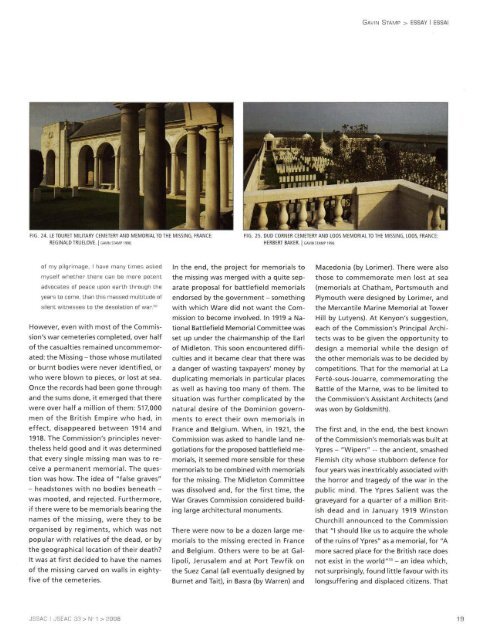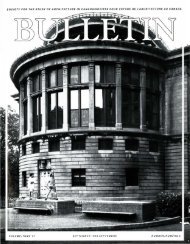CANADA - SEXTONdigital
CANADA - SEXTONdigital
CANADA - SEXTONdigital
Create successful ePaper yourself
Turn your PDF publications into a flip-book with our unique Google optimized e-Paper software.
G AVIN S TAMP > ESSAY I ESSAI<br />
FIG . 24. LE TOURET MILITARY CEMETERY AND MEMORIAL TO TH E MISSING, FRANCE:<br />
REGINALD TRUELOVE. I GAVIN STAMP 1990.<br />
FIG . 25. DUD CORN ER CEM ETERY AN D LOOS MEMORIAL TO THE MISSING, LOOS, FRANCE:<br />
HERBERT BAKER. I GAVIN STAMP 1990.<br />
of my pilgrimage. I have many t imes asked<br />
myself whet her there can be more potent<br />
advocates of peace upon earth t hr ough the<br />
yea r s to come. t han t his massed multitude of<br />
silent witnesses to the desolation of wara 2<br />
However, even with most of the Commission's<br />
war cemeteries completed, over half<br />
of the casualties remained uncommemorated:<br />
the Missing -those whose mutilated<br />
or burnt bodies were never identified, or<br />
who were blown to pieces, or lost at sea .<br />
Once the records had been gone through<br />
and the sums done, it emerged that there<br />
were over half a million of them: 517,000<br />
men of the British Empire who had, in<br />
effect, disappeared between 1914 and<br />
1918. The Commission's principles nevertheless<br />
held good and it was determined<br />
that every single missing man was to receive<br />
a permanent memorial. The question<br />
was how. The idea of "false graves"<br />
- headstones w ith no bodies beneath -<br />
was mooted, and rejected. Furthermore,<br />
if there were to be memorials bearing the<br />
names of the missing, were they to be<br />
organised by regiments, which was not<br />
popular with relatives of the dead, or by<br />
the geographical location of their death?<br />
It was at first decided to have the names<br />
of the missing carved on walls in eightyfive<br />
of the cemeteries.<br />
In the end, the project for memorials to<br />
the missing was merged with a quite separate<br />
proposal for battlefield memorials<br />
endorsed by the government - something<br />
with which Ware did not want the Commission<br />
to become involved. In 1919 a National<br />
Battlefield Memorial Committee was<br />
set up under the chairmanship of the Earl<br />
of Midleton. This soon encountered difficulties<br />
and it became clear that there was<br />
a danger of wasting taxpayers' money by<br />
duplicating memorials in particular places<br />
as well as having too many of them. The<br />
situation was further complicated by the<br />
natural desire of the Dominion governments<br />
to erect their own memorials in<br />
France and Belgium. When, in 1921, the<br />
Commission was asked to handle land negotiations<br />
for the proposed battlefield memorials,<br />
it seemed more sensible for these<br />
memorials to be combined with memorials<br />
for the missing. The Midleton Committee<br />
was dissolved and, for the first time, the<br />
War Graves Commission considered building<br />
large architectural monuments.<br />
There were now to be a dozen large memorials<br />
to the missing erected in France<br />
and Belgium. Others were to be at Gallipoli,<br />
Jerusalem and at Port Tewfik on<br />
the Suez Canal (all eventually designed by<br />
Burnet and Tait), in Basra (by Warren) and<br />
Macedonia (by Lorimer). There were also<br />
those to commemorate men lost at sea<br />
(memorials at Chatham, Portsmouth and<br />
Plymouth were designed by Lorimer, and<br />
the Mercantile Marine Memorial at Tower<br />
Hill by Lutyens). At Kenyon's suggestion,<br />
each of the Commiss ion's Principal Architects<br />
was to be given the opportunity to<br />
design a memorial while the design of<br />
the other memorials w as to be decided by<br />
competitions. That for the memorial at La<br />
Ferte-sous-Jouarre, commemorating the<br />
Battle of the Marne, was to be limited to<br />
the Commission's Assistant Architects (and<br />
was won by Goldsmith).<br />
The f irst and, in the end, the best known<br />
of the Commission's memorials was built at<br />
Ypres- " Wipers" -- the ancient, smashed<br />
Flem ish city whose stubborn defence for<br />
four years was inextricably associated w ith<br />
the horror and tragedy of the war in the<br />
public mind. The Ypres Salient was the<br />
graveyard for a quarter of a million British<br />
dead and in January 1919 Winston<br />
Churchill announced to the Commission<br />
that "I should like us to acquire the whole<br />
of the ruins of Ypres" as a memorial, for "A<br />
more sacred place for the British ra ce does<br />
not exist in the w orld" 33 - an idea which,<br />
not surprisingly, found little favour with its<br />
longsuffering and displaced citizens. That<br />
JSSAC I JSEAC 33 > N" 1 > 2008<br />
19
















